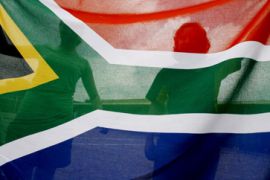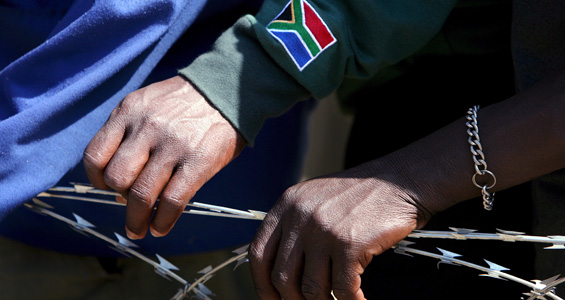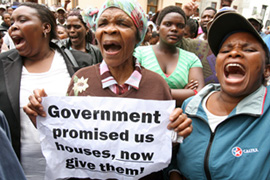Rainbow refugees and racism
Is S Africa’s racial unity merely a myth after a white citizen is given asylum by Canada?

 |
| Compromise made to attain political freedom seems to be holding back South Africa [EPA] |
“Racist” – that was the South African government’s response to Canada’s controversial decision to grant refugee status to Brandon Huntley, a 31-year-old white South African, who claimed he was being persecuted in his home country because of his race.
Given the Rainbow Nation’s peaceful transition from several decades of apartheid to democratic black majority rule – the ruling has attracted controversy in both local and international circles.
So, have the tables really been turned? Are white South Africans – nine per cent of the population and the country’s former rulers – now suffering discrimination and racism?
Huntley says that not only was he unable to find a job because of his colour, he also claims he was in grave danger because of being white.
The now ruling ANC was once staunchly left-leaning and often labeled as outright “communist” by the apartheid government.
The ANC’s proposed economic policy included redistributing the country’s resources, once freedom was eventually attained – as is evident from the liberation movement’s Freedom Charter.
The Freedom Charter, adopted at the Congress of the People, Kliptown, on June 26, 1955, states: “The national wealth of our country, the heritage of South African’s, shall be restored to the people.
“The mineral wealth beneath the soil, the banks and monopoly industry shall be transferred to the ownership of the people as a whole.
“All other industry and trade shall be controlled to assist the wellbeing of the people.”
Bloodbath fears
However, little is known outside of South Africa of what has been termed the “historic compromise”.
Negotiated when the apartheid government was in its dying days, high-profile ANC leaders, including Thabo Mbeki, a former president , agreed to the “historic compromise” which saw the ANC sacrifice some of the key demands stipulated in the Freedom Charter in exchange for political freedom.
 |
| Black South Africans are still significantly poorer than their white counterparts [EPA] |
The demand for nationalisation was abandoned. The banks were to be left alone, including the gold and diamond giants. The new ANC government even took on the international debt accrued under the previous apartheid regime.
Nelson Mandela, democratic South Africa’s first president and probably one of the greatest moral authorities of our age, was adamant that had this “historic compromise” not been made, South Africa would have been plunged into a bloodbath.
But 15 years on, with those promises to the majority still unfulfilled, many argue that a bloodbath did take place, albeit in a slower, more painful way, because of the compromise.
Recent worker protests and clashes with police have taken place in the big cities, as well as in other smaller towns like Siyathemba and Meyerton.
Construction and mine workers have taken strike action. The working class core of electricity giant Eskom has threatened to bring the company to a standstill if they do not raise wages.
Intriguing statistics
There are powerful indicators that South Africa is suffering from severe economic teething problems a decade and a half after gaining freedom.
However, those financial and social indicators do not suggest widespread discrimination against the nation’s white citizens.
The South African Institute of Race Relations reports that the average white household earns five times that of the average black household.
|
“Zuma faces the daunting challenge of fulfilling his promises of job creation and economic prosperity for the masses, while keeping big business and international investors happy” |
The statistics are intriguing. While 80 per cent of the population is black, a disproportionate amount of them live in poverty compared to their white counterparts.
It is estimated that 40 per cent of South Africans live beneath the poverty line, the majority of them black.
In 2007, Pius Langa, the country’s chief justice, lamented: “Even today, in our new dispensation, the ugly scars of systematic racial domination remain evident in unequal distribution of wealth; in the differing degrees of literacy and education; in the difference of infant mortality rates; in different standards of living.”
Also in 2007, a study by S van der Berg, M Louw and L du Toit at Stellenbosch University found only five per cent of black people in South Africa could be defined as “middle class and affluent”.
As a proportion of all “middle class and affluent” South Africans, 29 per cent are black.
Which means the remaining 71 per cent come from minorities – a fact that leads many to regard South Africa as one of the most unequal societies on the planet.
Black South Africans may have greeted the new era with the freedom to vote, but they have received little else so far. They are still substantially poorer than their white countrymen.
President Jacob Zuma faces the daunting challenge of fulfilling his promises of job creation and economic prosperity for the masses, while keeping big business and international investors happy.
Affirmative action
No leader since the end of apartheid, not even Nelson Mandela, has managed to achieve both. It is usually the former pledge that is first to be sacrificed.
Affirmative action policies and Black Economic Empowerment (BEE) implemented since the end of apartheid can justifiably be criticised for often creating a facade of transformation – in many instances blocking competent whites from the jobs they deserve.
Also, merely appointing a black CEO doesn’t mean a company has truly shrugged off the inequalities of the past. True economic and social transformation may need a more holistic approach, especially at the bottom of the economic ladder.
|
“I have watched my classmates and work colleagues, black, white, Indian, Malay and coloured (mixed-race) suffer from the appalling surge of crime… and can attest that crime in South Africa doesn’t see colour” |
But despite BEE, the statistics still fascinate. The freshly released Employment Equity report released by the labour ministry highlighted that 61 per cent of directors and managers of companies are white – compared to nine per cent black.
Hijackings, muggings, robberies, burglaries, rapes – South Africa is no stranger to these societal ills.
The crime rate has rocketed and is now a big concern, not least because the Fifa World Cup will be held in the country in less than a year.
In addition to that, increasingly frequent incidents of xenophobic violence have shocked the nation and its neighbours. Experts have linked this violence directly to the economic frustrations of the masses.
Perhaps the biggest symptom yet of the ANC’s unfulfilled economic promises has been the widely spread, but erroneous, perception among poor citizens that migrants from Zimbabwe, Mozambique, Somalia and other African countries are taking South African jobs.
Violent attacks on fellow black Africans have created fear and instability – oftentimes downright anarchy – in the cities and towns.
These attacks can be explained as a sickening outburst of unjustified violence from shack-dwellers and desperate urban strugglers who began to wonder if fighting so hard and enduring so much during apartheid was utterly futile.
Much of the population is unemployed and lacking access to decent education and running water.
Crime colour-blind
Some still do not have electricity. When the biting Johannesburg winter chill hits squatter camps – euphemistically called “informal settlements” – like Slovo Park, the shack-dwellers, all black, do not even have blankets.
It is within these squatter camps – and the big townships – that a large percentage of crimes, xenophobic or not, take place in South Africa.
Huntley claims to have been attacked seven times in South Africa, and this is not the place to dispute his claim. He may actually be one of the lucky South Africans whose experience of crime has not hit double figures. But was he attacked because he was white?
As a South African of Indian descent, I have experienced crime first hand – one of my brothers has been the victim of a “car-jacking”, my father and another brother have been robbed at gunpoint, my wife and mother have been mugged and my house burgled by white men according to the eyewitness neighbours.
I have watched my classmates and work colleagues, black, white, Indian, Malay and coloured (mixed-race) suffer from the appalling surge of crime in all its most simple and outrageous forms and can attest that crime in South Africa does not see colour.
In justifying its decision to approve his refugee application, Canada’s refugee board said Brandon Huntley would “stick out like a sore thumb” if he went back to South Africa.
Mowbray, the part of Cape Town Huntley hails from, is middle class, has a golf course and is largely white.
One cannot help wondering if the opposite would prove to be true. A black family moving into Mowbray might just be the ones sticking out like a sore thumb.
The views expressed in this article are the author’s own and do not necessarily reflect Al Jazeera’s editorial policy.